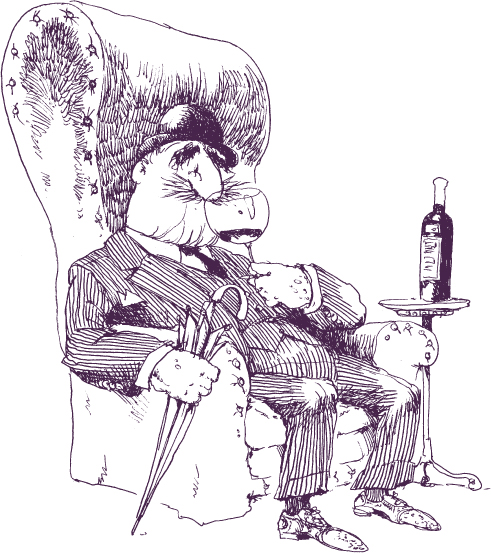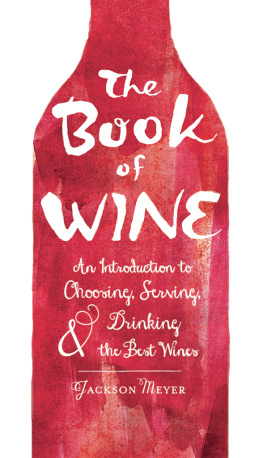Cellaring Wine

Cellaring Wine
Managing Your Wine Collection to Perfection
Whimsical illustrations by William Bramhall
JEFF COX

The mission of Storey Publishing is to serve our customers
by publishing practical information that encourages
personal independence in harmony with the environment.
Edited by Dianne M. Cutillo and Marie A. Salter
Art direction and cover design by Cynthia McFarland
Cover illustration Riley Illustration: William Bramhall
Whimsical interior illustrations Riley Illustration: William Bramhall,
; all other illustrations by Brigita Fuhrmann
Text design and production by Karin Stack
Production assistance by Jennifer Jepson Smith
Indexed by Susan Olason/Indexes & Knowledge Maps
Copyright 2003 by Jeff Cox
All rights reserved. No part of this book may be reproduced without written permission from the publisher, except by a reviewer, who may quote brief passages or reproduce illustrations in a review with appropriate credits; nor may any part of this book be reproduced, stored in a retrieval system, or transmitted in any form or by any means electronic, mechanical, photocopying, recording, or other without written permission from the publisher.
The information in this book is true and complete to the best of our knowledge. All recommendations are made without guarantee on the part of the author or Storey Publishing. The author and publisher disclaim any liability in connection with the use of this information. For additional information, please contact Storey Publishing, 210 MASS MoCA Way, North Adams, MA 01247.
Storey books are available for special premium and promotional uses and for customized editions. For further information, please call 1-800-793-9396.
Printed in the United States by Von Hoffmann
10 9 8 7 6 5 4 3 2 1
Library of Congress Cataloging-in-Publication Data
Cox, Jeff, 1940
Cellaring wine : managing your wine collection to perfection / by Jeff
Cox.
p. cm.
Includes index.
ISBN 1-58017-474-4 (alk. paper)
1. Wine and wine making Amateurs manuals. 2. Wine cellars
Amateurs manuals. I. Title.
TP548.2.C69 2003
641.22dc21
2003045641
To the vineyard workers, who toil so that we may drink wine.

Preface
In From Vines to Wines, the companion book to this volume, I detailed the process of choosing the site of a vineyard, selecting grape varieties for the site, growing the grapes, and making wine from them. In this book, I describe the journey of the finished bottle of young wine whether made from your grapes or a bottle you have purchased to its ultimate destination on your table as a perfectly aged wine, faceted not only with layers of fruit but with the accoutrements of age: silken smoothness, generosity of flavor, and the fragrances of bouquet that only arise with sufficient time in the bottle.
If, as I said in From Vines to Wines, wine is the child of the marriage of a human being and grapevine, then to know that wine in the fullness of its maturity is to know the child grown to the full power of its adulthood. Well-aged wine is as different from the product that first went into the bottle as an adult is from a child. Its youthful appeal may be diminished, but its complexity and depth can be infinitely greater.
Wine can achieve these heights only if it is handled properly during its years of maturation. That takes a wine cellar. Although I loved fine wine as a young man, I never thought about having a wine cellar of my own until one November nearly 30 years ago when I visited friends in France.
A more volatile couple can hardly be imagined he a reserved, upper-class Englishman, she a fiery, libidinous Frenchwoman. After a few days of listening to them bicker in the confines of their Paris apartment, I was thankful that they offered to drive us all down to her mothers chteau near the city of Angoulme so we could spend some time in the countryside. Her mother, who must have had considerable wealth, was in Paris at her own apartment for a few weeks, and so the chteau was available for us.
Angoulme is in the department of Charante, where Cognac is made, about 300 miles southwest of Paris. To the south of Charante are the departments of Dordogne and Gironde, which hold the culinary and vinous treasures of Prigord and Bordeaux and offer plenty of opportunity for day excursions. We left Paris early and made a noontime stop in Saumur, where we visited a winemaker. After we sampled his very good white (but astringent red) wine, he led us to one of his chais, where a staircase descended into caves carved three levels down into the underlying chalk. The air in the caves was close, and the bottles of wine stored in the lowest level covered with the dust of decades. During the war, he said, referring to World War II, we hid all our wine and valuables down here, to keep them from the Nazis. The Nazis never did discover the entrance to the caves, he said, because it was then hidden under the manure-encrusted floorboards of a horse stable.
We arrived in Angoulme at night, exhausted. The next morning, I rose early to look around. The chteau was a grand house dating from the early eighteenth century. Behind the house was a copse of trees that turned out to be, on close inspection, overgrown filberts, and a clos with a vegetable garden and a gate in its wall. Through the gate, a path led through a pasture of ripe-smelling grasses and dried weeds to a nearby dairy farm. Later that morning, and every morning for the two weeks we stayed there, one of us would take a silver pail and walk the quarter mile path to the farm, where rich whole milk still warm from the cow would be poured foaming into the pail.
I reveled in the niceties of rural France. The estates caretakers collected our dirty clothes and laundered them outside, scrubbing them on a washboard in a tub of soapy water kept hot with boiling water from a cauldron hung over a wood fire. We purchased meat and eggs from a truck that pulled up every day about noon. The butcher let down a long flap on the side of the truck and climbed into the enclosure, the flap becoming a counter on which he set a basket of fresh eggs, ham, steaks, and chops for us to choose from.
The house itself was intriguing two stories with long hallways that ran the length of the building, opening onto rooms filled with antique French furniture. Although the kitchen was updated with a refrigerator, gas stove, and oven, it was easy to see its original appearance in the ancient tiled walls and flagstone flooring.
On my second afternoon there, I wandered into the clos to see what was growing and discovered a set of steps leading down to a cellar-level room under the chteau. An ironwork gate barred the entranceway to the cellar. A large padlock secured the gate to an iron rod cemented into the masonry. Inside I could dimly see a table, some shelving, lots of cobwebs, and a number of dusty wine bottles lying on their sides.
Excited by my find, I ran back up into the house to see if Corrine had a key. Somewhere here, she said in her thick French accent. When we were kids, my cousins and I would always try to break into the cellar to steal the wine, so my father put up that gate to keep us out. Im sure the key is here somewhere. And though she looked high and low as I waited impatiently, she couldnt find it.
Next page

















